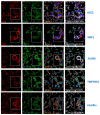The Tetraspanin CD9 Facilitates SARS-CoV-2 Infection and Brings Together Different Host Proteins Involved in SARS-CoV-2 Attachment and Entry into Host Cells
- PMID: 40872854
- PMCID: PMC12390632
- DOI: 10.3390/v17081141
The Tetraspanin CD9 Facilitates SARS-CoV-2 Infection and Brings Together Different Host Proteins Involved in SARS-CoV-2 Attachment and Entry into Host Cells
Abstract
CD9 protein belongs to a family of proteins called tetraspanins, so named for their four-transmembrane-spanning architectures. These proteins are located in domains in the plasmatic membrane, called tetraspanin-enriched microdomains (TEMs). Several proteases and cellular receptors for virus entry cluster into TEMs, suggesting that TEMs are preferred virus entry portals. Severe Acute Respiratory Syndrome coronavirus 2 (SARS-CoV-2) spike (S) protein mediates virus attachment and entry into cells by binding to human angiotensin-converting enzyme 2 (ACE-2). In addition, the secretory, type-I membrane-bound SARS-CoV-2 S protein is synthesized as a precursor (proS) that undergoes posttranslational cleavages by host cell proteases, such as furin and TMPRSS2. Moreover, it has been shown that neuropilin-1 (NRP1), which is known to bind furin-cleaved substrates, potentiates SARS-CoV-2 infectivity. Our results indicate that CD9 facilitates SARS-CoV-2 infection. In addition, we show how knocking out CD9 leads to a decrease in the expression of NRP1, a protein that improves SARS-CoV-2 infection. Furthermore, we show that CD9 colocalizes with ACE-2, NRP1, furin, and TMPRSS2 at the plasma membrane; that the absence of CD9 decreases the expression of these proteins on the plasma membrane CD9-enriched microdomains, and that CD9 interacts with ACE2. In conclusion, our data suggest that CD9 facilitates SARS-CoV-2 infection and that CD9 brings together different host proteins involved in SARS-CoV-2 attachment and entry into host cells, such as ACE2, NRP1, furin, and TMPRSS2. Importantly, the fact that a blocking antibody targeting CD9 can effectively reduce SARS-CoV-2 titers highlights not only the mechanistic role of CD9 in viral entry but also offers translational potential, suggesting that tetraspanin-targeting antibodies could be developed as therapeutic agents against SARS-CoV-2 and possibly other coronaviruses, with meaningful implications for clinical intervention.
Keywords: ACE2; CD9; NRP1; SARS-CoV-2; proteases TMPRSS2 and furin; tetraspanins; virus entry; virus-host interactions.
Conflict of interest statement
Author Daniel Torralba was employed by the PharmaMar S.A. The other authors declare no conflicts of interest.
Figures







Similar articles
-
Determinants of susceptibility to SARS-CoV-2 infection in murine ACE2.J Virol. 2025 Jun 17;99(6):e0054325. doi: 10.1128/jvi.00543-25. Epub 2025 May 12. J Virol. 2025. PMID: 40353671 Free PMC article.
-
Glycoproteomic characterization of Neuropilin-1 reveals critical glycosylation sites for SARS-CoV-2 entry.Biochim Biophys Acta Proteins Proteom. 2025 Sep 1;1873(5):141089. doi: 10.1016/j.bbapap.2025.141089. Epub 2025 Jul 14. Biochim Biophys Acta Proteins Proteom. 2025. PMID: 40669529
-
Diesel exhaust particle inhalation in conjunction with high-fat diet consumption alters the expression of pulmonary SARS-COV-2 infection pathways, which is mitigated by probiotic treatment in C57BL/6 male mice.Part Fibre Toxicol. 2024 Sep 29;21(1):40. doi: 10.1186/s12989-024-00601-w. Part Fibre Toxicol. 2024. PMID: 39343929 Free PMC article.
-
Receptor Binding for the Entry Mechanisms of SARS-CoV-2: Insights from the Original Strain and Emerging Variants.Viruses. 2025 May 10;17(5):691. doi: 10.3390/v17050691. Viruses. 2025. PMID: 40431702 Free PMC article. Review.
-
Presence of SARS-CoV-2 and Its Entry Factors in Oral Tissues and Cells: A Systematic Review.Medicina (Kaunas). 2021 May 23;57(6):523. doi: 10.3390/medicina57060523. Medicina (Kaunas). 2021. PMID: 34070998 Free PMC article.
References
MeSH terms
Substances
Grants and funding
- PID-2021-123810OB-I00/MCIN/ AEI /10.13039/501100011033/ and FEDER
- CNS2022-135276/MCIN/AEI/10.13039/501100011033 and the European Union NextGenerationEU/PRTR
- 2021-050-INTRAMURAL NOV-SAALM/FINBA-ISPA through the call for Early-Career Researchers, sponsored by JANSSEN
- Grant IDE/2024/000775, through the projects PI22/00738 and PI23/00567/PCTI-Plan de Ciencia, Tecnología e Innovación 2024-2027 from the Gobierno del Principado de Asturias
LinkOut - more resources
Full Text Sources
Medical
Miscellaneous

